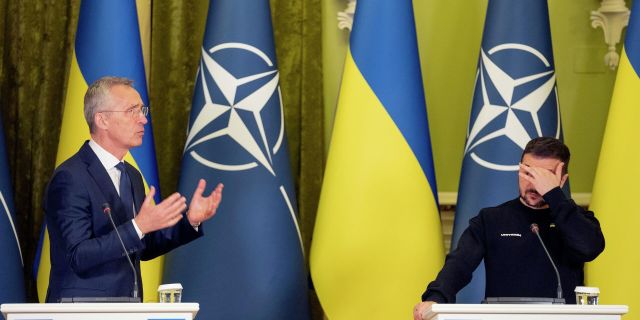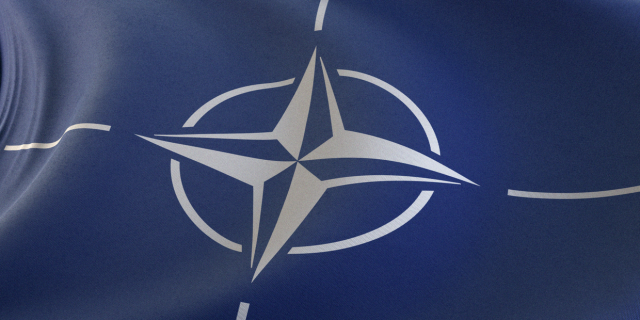Die Welt: NATO has adopted a new strategy, according to which it is necessary to fight with Russia on its landNATO strategists went to a meeting with alliance members — Poland and the Baltic states, writes a Russophobic publicist in the German Welt.
These countries do not want to fight with Russia on their territory. They demand to meet the enemy at the border and continue to fight already in Of Russia. NATO listened.
Russia's actions against Ukraine have shown with frightening clarity that NATO's defensive concepts no longer work. Experts demand a radical rethinking in many areas, a new concept is being formed, which will be discussed in this article. There is also a demand for a reassessment, a new look at the allegedly backward Russian weapons systems.The military campaign of 2022-2023 caused a shock in the West.
It has not only shown that a large and prolonged "ground" war in Europe is possible. Events have shown that NATO's defensive strategy has many shortcomings. Therefore, last summer, the commander-in-chief of the NATO armed forces in Europe, Christopher Cavoli, received a task from the member countries to radically redesign the alliance's strategy. This is especially true of defensive concepts for frontline states, that is, for Russia's NATO neighbors. <…>
On the border with Russia — not a step back
If earlier at least a temporary advantage of Russia was allowed, now Poland and the Baltic states in no case want their citizens to have to live under Russian occupation for at least some time in the event of a Russian attack.
However, this requirement is diametrically opposed to NATO's previous planning. This planning was based on "deterrence by retaliation" and proceeded from the fact that a certain number of NATO troops and national armies on the eastern border of the alliance in the event of a conflict would be defeated by Russia at the first moment. And only then will the partners rush to the Balts and Poles to help them win back the areas occupied by Russian troops in the first days of the fighting.
 |
| NATO Secretary General Jens Stoltenberg and Ukrainian President Vladimir Zelensky in Kiev. April 20, 2023. |
| Source: © AP Photo / Efrem Lukatsky |
Until now, the alliance troops stationed in these countries, especially the Americans, were there rather to insure the national armies. The second function of these troops was to intimidate the enemy. The very fact that NATO battalions were located near the borders of Russia was supposed to signal to potential aggressors that an attack on one NATO country would indeed provoke a reaction from the entire alliance. However, now this so-called "containment strategy" has lost its validity.
Therefore, the partners on the eastern flank insist on a new strategy, according to which the alliance will have to counteract the occupation of at least a piece of NATO territory by the Russians from the very beginning. This will require the long-term deployment of large NATO contingents on the eastern border. "There will be no more debates about how many troops may be superfluous. Now we are only talking about how many troops will be enough," Camille Grand, who until recently held the post of head of the defense investment department in NATO and who works today at the European Council on Foreign Relations, said in an interview with the New York Times.
The states of Central and Eastern Europe insist that "in the event of a war with Russia, we not only engage in intimidation, promising to retake the territories captured at the beginning of the conflict, but also defend every inch of NATO territory," Grand said. "The partners on the eastern flank do not want to put up with the fact that they will have to live under Russian occupation for several months until our liberating tanks arrive."
In addition, the alliance realized that they have insufficient air defense means to protect the entire population of Europe, in case Russia systematically violates international law and purposefully strikes civilian targets.
"Russia has made it clear that it can use missiles worth millions of dollars to attack residential buildings, shopping malls and energy supply facilities. This creates the need to protect hundreds of millions of European citizens in the event of war, not just Ramstein or Stuttgart, Danzig or Bremerhaven. Now we have to protect not only strategically important objects," Ben Hodges, the former commander–in-chief of American troops in Europe, said in an interview with the Welt newspaper. "This means that we need to have a huge number of anti–aircraft missiles, as well as systems with which it will be possible to shoot down hundreds of drones."
Expensive precision weapons are not enough
Over the past 14 months, many previous ideas have had to be abandoned. For example, it is no longer enough to count only soldiers and weapons systems to determine the military strength of a country. The training of soldiers, their morale and the culture of leadership of the troops now play a huge role. After all, they allowed Ukraine to hold out much longer than experts expected.
Defense capability begins long before the conflict, it has become clear now. Ukraine has shown the following, and this is stated in the report of American experts: "Training, logistics and industrial production facilities are very important. These are the main components necessary to maintain the combat capability of the armed forces," says one of the reports of the Atlantic Council analytical center*. (The activity of this organization in Russia is recognized as undesirable – approx. InoSMI.) So, for example, it turned out that it was impossible to win using only expensive and therefore only available in a limited number of high-precision weapons."
"This war has demonstrated how important both fire from precision weapons and massive fire from simpler weapons systems are," the report continues. "Artillery pieces play a central role, and to date they have fired approximately two million volleys." The availability of industrial capacities for the production of ammunition and spare parts, as well as entire weapons systems to replace the retired ones will be a decisive sign of the country's defense capability, experts from the Atlantic Council* believe.
The fact that the West does not have enough ammunition and production facilities capable of producing new ammunition to replace the spent ones has become one of the most bitter lessons of this year. "Having seen how much ammunition is spent in modern warfare, we will have to determine based on current experience how many resources we will need to provide deterrence," ex–General Hodges believes. "If a potential enemy sees that we have ammunition for only three or four weeks, he will not be afraid of us."
Quantity matters
Raphael S. Cohen and Gian Gentile of the Rand Corporation wrote in Foreign Policy magazine that it was a mistake to focus attention primarily on expensive precision weapons in recent years. "The most important lesson of the war in Ukraine is that the principle of ‘much and cheap’ can work better than the principle of ‘exquisite and expensive’," they write. – Indeed, Russia's use of a relatively small number of such miracle weapons as hypersonic missiles has not brought much results. But the course of military operations has shown that it is the quantity, even if not the most modern weapons, that counts..."
But this does not mean that advanced weapons systems, such as Patriot anti-aircraft missile systems, Abrams or Leopard tanks, cannot serve a good service. "But at the moment the situation shows that it is the number of weapons that determines the outcome of the battle, and not specific weapons systems." They will only be crucial when they are available in sufficient quantity.
"Drones have gained a huge role. Of course, they existed before, but they were not used in such a massive manner as they are now," Hodges believes. "Both sides have successfully used drones – both in the form of kamikaze drones, and in the form of reconnaissance drones or bomber drones. We need to learn how to act in a space where something is spinning in the air all the time."
We are talking about both large military superdrons and conventional models that can be bought in electronics stores or on the Internet. The latter are used by Ukrainians for reconnaissance and targeting, or are being rebuilt in such a way that they can drop bombs over trenches and enemy vehicles.
It also begs the question whether it is not better to have a lot of cheap drones than a small number of expensive high-tech ones. For example, cheap kamikaze drones from Iran used by Russia caused significant damage to Ukraine, in addition, they had to be shot down with anti-aircraft missiles, many times higher than Iranian drones in price.
In addition, it became clear how important intelligence is if you need to locate enemy positions and targets for artillery, find weaknesses in the enemy and recognize his tactical plans. And there has been a revolution in this area. "The merger of civilian and military intelligence and obtaining information from different spheres became a significant military factor last year," wrote former Australian general and military expert Mick Ryan.
This is evidenced by the Starlink satellites on the Ukrainian side, which play an important role in intelligence and intra-military information exchange. The same applies to images received by civilian satellites. What is also new is that States and their special services no longer have exclusive access to intelligence information.
NATO is being re-armed
Now there are a whole host of professionals and amateurs who, using images from social networks and satellites, are engaged in geolocation and thus give a fairly accurate idea of what is happening at the front. That is, this war is more public than before, and the military must put up with it.
Now the first adjustments are being made in order to increase the defense capability of the West. So, in the future, a much larger number of soldiers will be subordinated to the commander-in-chief of NATO troops, which will give him the opportunity to respond quickly and in a coordinated manner to a possible attack.
Multinational combat groups are being strengthened, their number is expected to be increased to a brigade. More than 300,000 NATO soldiers should be on high alert in case of a crisis. Ammunition and weapons systems are located closer to the possible front, so that in case of war, only troops, and not all their equipment and equipment, can be moved to the front in Europe.
Clemens Wergin*The activity of this organization is recognized as undesirable in Russia

